Garden geranium
Geranium decorated garden
Many novice gardeners, especially those who are far from botany, think that geranium and pelargonium are one and the same. In fact, these are two different kinds of the same geranium family (Geraniaceae). If all pelargoniums (Pelargonium) are heat-loving plants that are grown only as indoor plants in our climate, then many members of the geranium (Geranium) genus feel great in the open field. In addition, they differ greatly in morphological features (flower and inflorescence shape, etc.).
The fashion for the cultivation of garden geraniums came to us quite recently from Europe, just as it happened with many other cultures. In the West, real interest in these modest plants arose only in the 20th century, first in England, where such famous growers as E. A. Bowles and A. T. Johnson were engaged in hybridization, and later in Holland. In the 1980s, large monographs on geraniums were published in these countries. And over the past 20 years, the picture has changed a lot. Many new hybrids and decorative forms of geraniums appear on the mass market. The homeland of almost all the novelties is still the UK, which is obviously connected with the strong English traditions, as well as with the favorable climate of this country. The source material has a different origin - the Caucasus, China, India, North America, Europe, where there are winter-hardy species of geraniums.
The ovary of a geranium is similar to the crane's beak, and the name “geranium” comes from the Greek “geranos” - the crane
Recently, accents have shifted in the idea of the beauty of the garden, the almost forgotten concept of landscape design has reappeared. Natural parks and forest gardens pressed the ceremonial flower beds, so many plants came to the fore, valued not only for beautiful flowering, but also for spectacular foliage that retains decorativeness throughout the summer, or an attractive habit (form dense compact bushes of various shapes, grow thick carpet, etc.).
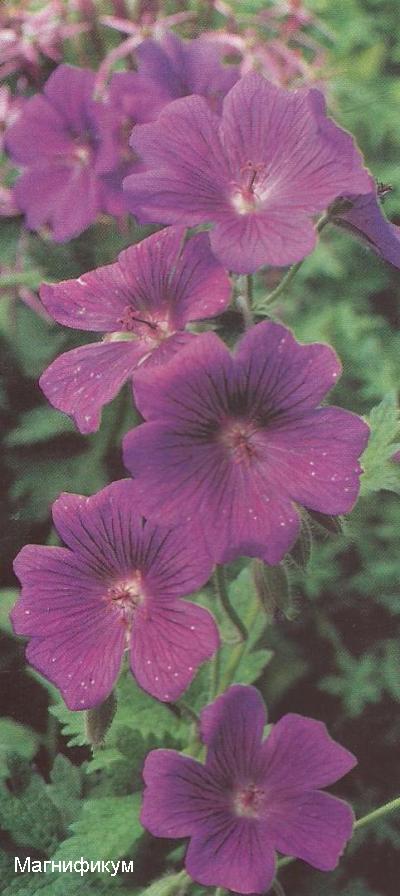 Geraniums turned out to be just such plants due to their many qualities. Most of them form beautiful hemispherical shrubs, rounded leaves can be cut to varying degrees, some have a strong spicy aroma, they are well preserved until frost, they become beautiful in autumn, and in some species even come out in spring green from under the snow. Most modern hybrids and decorative forms bloom beautifully, however, the duration of flowering varies greatly. In addition, one of the most fashionable trends in garden design today is variegated plants, and geraniums are far from the last place here.
Geraniums turned out to be just such plants due to their many qualities. Most of them form beautiful hemispherical shrubs, rounded leaves can be cut to varying degrees, some have a strong spicy aroma, they are well preserved until frost, they become beautiful in autumn, and in some species even come out in spring green from under the snow. Most modern hybrids and decorative forms bloom beautifully, however, the duration of flowering varies greatly. In addition, one of the most fashionable trends in garden design today is variegated plants, and geraniums are far from the last place here.
The colors of geranium flowers lack yellow and orange colors, most commonly pink, blue, red and white, as well as purple, lilac, purple, magenta, salmon.
One of the most beautiful geraniums magnificum decorate any composition.
In this case, the first three colors are never clean, they always have some impurity. There are also flowers with contrasting venation (purple or pink pattern on a white background), with contrasting eyes (black center - crimson petals, white center - pink petals).
The height of different species varies from 10 to 125 cm, which allows the use of geraniums in various compositions.
Far from all cultivars of geraniums that flourish in Western Europe feel well in conditions of central Russia. This was particularly clearly demonstrated by the past winter, which turned into big losses for the florist.
Here are the most viable and winter-hardy species and hybrids recommended for growing in a cold-temperate zone.
The meadow geranium (Geranium pratense) is a widespread species, a short-rhizomatous perennial, the height of dense bushes is from 80 to 125 cm, the leaves are divided into 5-7 lobes, large lilac-blue flowers bloom in early summer. There are varieties with flowers of different colors and with purple leaves:
Galaxies - albino, white flowers, light green leaves.
Mrs. Kendal Clark - lavender flowers with white venation, the bush is falling apart.
Rose Queen - pale pink flowers with orange stamens.
Silver Queen - flowers with black stamens change the color intensity depending on the weather - from light purple to dry and warm to much darker to cloudy and cool.
Striatum - on a white background of petals blue specks and strokes, the pattern is unstable, on the same plant can be found blue and white flowers.
There are three terry varieties, their height- 80 cm:
Album Plenum is a very rare form with medium-sized white terry flowers having a light lilac shade.
Ceruleum Plenum - terry purple-blue flowers.
Violaceum Plenum - bluish-purple flowers, reddish in the center.
Varieties with red-purple and black-purple leaves - Midnight Reuters, Victor Reuters, Pearl Heron, the flowers have dense purple.
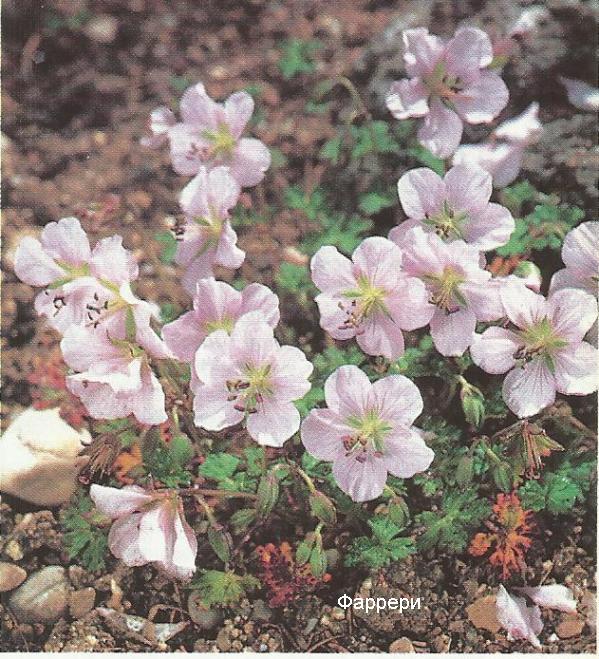
Geranium farreri- charming Chinese view for alpine hills more than 12 cm high, flowers up to 3.5 cm in diameter. It is frost-resistant, does not take out a winter wetting.
The meadow geranium prefers well-lit places with moisture-intensive soils. It is perfectly combined in its appearance with other plants that are suitable for the same conditions: it is a terry meadow core, a meadow-leaved meadowsweet terry and yellow-motley, graviatat with pinkish-brownish-orange abundant flowers, blue variegated blue, buttercup spiny terry, crested phytophagous moth, blue-colored, blue-colored, blue buttermilk, caustic terry, lupine flowers. Basilists are yellow and light, European bathing-house and its varieties, forest kupyr with dark foliage, pointstrike. With the help of these plants, you can create exquisite compositions, such as a mixborder, using techniques of contrast, harmony and nuances of form and color. In the foreground of such a mixborder, hardy ground cover plants - a creeping tentacle, a coinatorial montretine golden will organically look.
Geranium red-brown (Geranium phaeum) - forest species from Central Europe, short-perennial perennial, prefers shady places with loose moist soils, but tolerates dry, decorative from early spring to frost due to early growing beautiful leaves and the hemispherical shape of the bush, reaching 50 cm in height (with inflorescence 90 cm). It blooms in the first half of summer with small purple-brown flowers. The leaves of this geranium are slightly incised at 7-9 lobes. In nature, there are forms with purple-brown spots at the base of the cuts.
Best cultivars:
Album - white flowers, larger than those of the natural species, and light green leaves. Well suited to create a color effect in a shady corner of the garden.
Lily Lowell - large blue-purple flowers and light green leaves, one of the most spectacular forms.
Stilingfleet GOST - small leaves and purple-gray flowers.
Langthorne Blue - similar to the previous form, but with a predominance of purple hue.
Calligrapher - narrow wavy petals.
Rose Mader - beautiful brownish-pink flowers.
Samobor - is considered one of the most beautiful decorative and hardwood geraniums. On the dark green background of the leaf is a brown-black stripe formed by merging spots. To achieve maximum decorativeness, rich, well-moistened soil is needed. Other variegated varieties - Variegatum, Tafs Jester, Maggis Dilight have a cream or pale green edging of leaves.
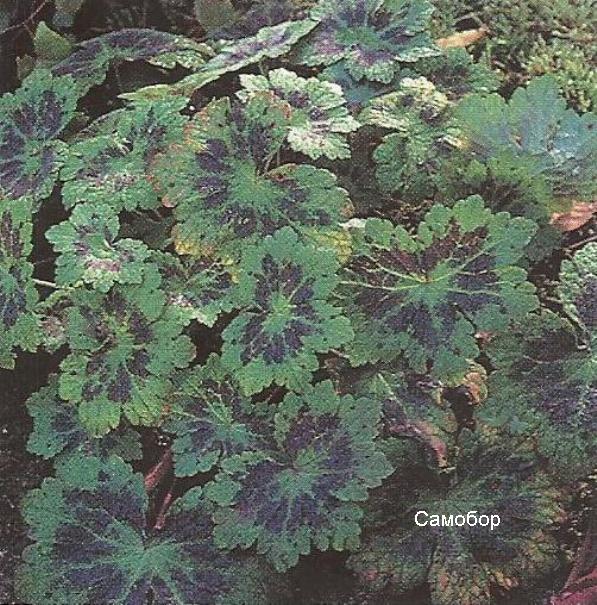
Red-brown geranium will look great on the edge or among shrubs in the company of large host, forest ferns and grasses, aquilegia ordinary, yalnotki eagle, basille-bearing basal, crested insect, and hellebore east. Forest geranium, which loves forest coolness, especially in the hot season, will perfectly fit here. Forest geranium is a widespread European species, short-rhizomatous perennial with elegant deeply dissected leaves and bluish-lilac flowers with white center, blooming in late spring. She also has decorative forms: Baker Pink - with light pink flowers, Album with white, And maculi - large-flowered, Mayflower - with blue-violet flowers and the bluest of all - Amy Doncaster. Decorative shapes are propagated by dividing the bush.
Blood-red geranium (Geranium sanguineum), widespread in most parts of Europe, is a low short perennial with strongly dissected openwork leaves forming small domes up to 45 cm high. It blooms in summer with large carmine-red flowers, has decorative forms:
Album - white flowers and less compact bush.
Angums Pride - pink flowers, long flowering.
Cedric Morris and Elsbet are large flowers of magenta color.
Glenlus - a powerful bush with purple-purple flowers.
Nanum, Lancastreensee, Jubili Pin and Sheferos Warning are dwarf forms.
Max Frey is a variety with a particularly compact bush.
Variety G. sanguineum var. striatum- one of the most beautiful, with a bright pink veining on a pale pink background of petals. Variety Splendes like her, but a little brighter.
Lid with Forms is the most powerful of all with large bright flowers of magenta color.
Forms of blood-red geraniums find various uses in garden design - in rockeries, on beds with perennials, along the edges of the paths.
Propagated by dividing the bush and root cuttings.
Geranium large-rhizomatous (Geramium macrorhizum) hails from the Alps and the Carpathians, quickly forms a closed cover up to 30 cm high with woody lodging stems, fragrant leaves in the fall acquire a beautiful color. This geranium is very unpretentious, grows well in partial shade and tolerates even a dry shade under the canopy of trees. It blooms in early summer, the flowers are small, bright pink.
There are decorative forms:
Album - almost white, slightly pinkish flowers.
Whiteness - albino, pure white flowers and pale green leaves.
Bevan "with Veraeti - bright two-ton raspberry-red flowers.
Ingerssens Veriati - pale pink flowers.
Tsakor - bright magenta-purple flowers.
Variegatum - leaves with cream specks.
This species is used as a universal ground cover plant, a dense closed carpet leaves no chance for weeds. Decorative forms are propagated by dividing the bushes and rooting segments of rhizomes.
The Geranium of Cantabrigia (Geranium x cantabrigiense) is similar in shape to the previous one, but it does not grow so much. This is a hybrid of large rhizome and geraniums of Dalmatian geranium.
Geranium magnificum (Geranium x magnificum) - a hybrid of flat-leaf geranium (G. platipetalum) and Georgian geranium (G. ibericum), cultivated since the 19th century, is a beautiful garden plant that forms powerful bushes up to 70 cm. It grows with short underground stolons. The only drawback is not very long flowering. The flowers are large, up to 5 cm in diameter, lilac-blue. It develops best in open sunny places, tolerates partial shade, but the flowering is not so impressive, and the stems weaken and lie down.
In garden design can serve as a bright color accent, and a transitional element in various compositions. After flowering, lush bushes from large beautiful half-dissected leaves retain their decorativeness until autumn.
Himalayan geranium (Geranium himalayense) forms friable bushes with a height of 30-40 cm. The leaves are slightly dissected, the flowers are large, 4-6 cm in diameter (in size of flowers it is a champion in the geranium genus).
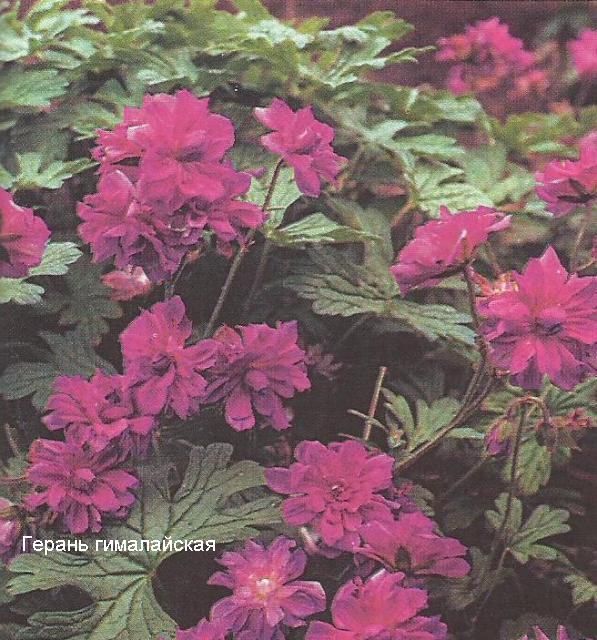
Graveti form has very beautiful large flowers of almost pure bright blue color.
There is a terry form Plenum, which is also called Birsh Double, it is lower and more compact than the natural look.
A hybrid of this species with a meadow geranium — a popular garden plant — is called Johnson Blue.
Geranium erianthum (Geranium erianthum) is one of the most frost-resistant species, it is found in nature from Eastern Siberia to Alaska. Forms compact bushes up to 50 cm in height, flowers in dense umbellate inflorescences, color - from lilac to purple.
Dalmatian geranium (Geranium dalmaticum) from Eastern Europe is one of the lowest species, not more than 15 cm in height, it grows with large pillows, decorative during the growing season. It blooms in mid-summer with bright pink flowers up to 3.5 cm in diameter, the leaves are smooth, dissected into 5-7 lobes, up to 4 cm long.
Geranium cinereum (Geranium cinereum) is an alpine species, also miniature, its sockets do not exceed 15 cm in height, flowers up to 2.5 cm in diameter, white or pink, bloom in early summer. The most popular forms are: Album - white flowers, Ballerina - pink flowers with purple venation.
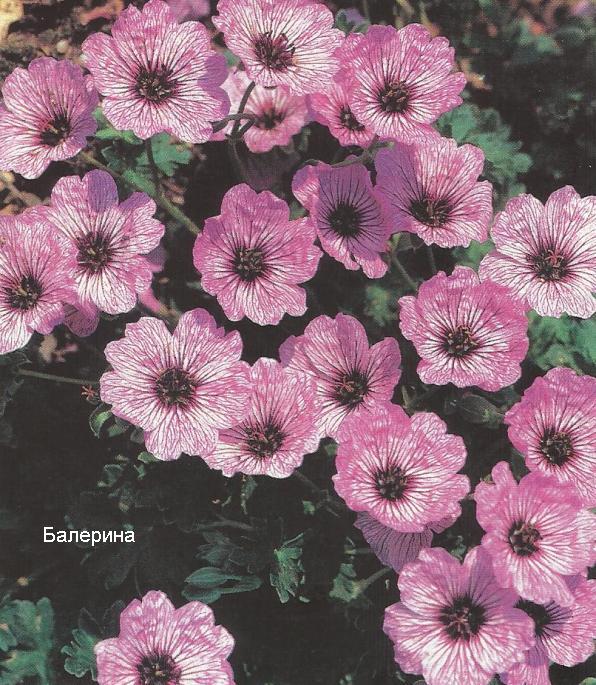
One of the most worthy representatives of the genus is Caucasian geranium Renardia (Geranium renardii). The plant forms compact bushes up to 20 cm in height with gray or olive-green "velvet" round leaves, dissected to the middle by 5 shares. This species is valued precisely for the beauty of the foliage, its flowers are not very spectacular - almost white or pale lilac with dark lilac veins. Decorative leaves perfectly preserved all summer.
A. Rubinina , biologist, Moscow Flower Club
(Garden and garden № 5, 2003)
Garden geranium
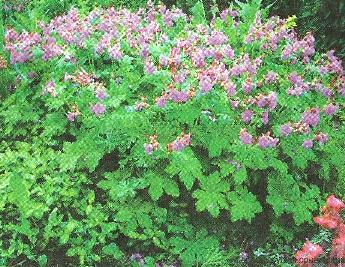
Everybody knows geranium, or pelargonium, as a houseplant, some gardeners plant it in the summer on flowerbeds, and have begun to use parks and gardens for landscaping.
Geranium blooms magnificently, brightly, but with the arrival of autumn, these plants are ruthlessly thrown away, because they do not hibernate in our area. But there are real geraniums growing in forests, meadows, in the mountains, and on their basis garden forms are derived, which they gladly plant in Western Europe and England. These are perennial geraniums that winter well in the open field. The attractiveness of these plants is combined with lack of care and endurance, which is natural for plants introduced into the culture relatively recently. Geraniums are good not only during flowering. Their carved foliage is beautiful throughout the growing season.
There are more than 300 known species of geraniums, common on all continents. All geraniums are combined in their own family of geraniums. There are annual geraniums, perennial herbaceous plants, but there are also shrubs. Often stems and leaves with strong pubescence. The leaves are rounded, dissected, on long petioles. Flowers with five petals, single or assembled in several pieces in racemes or corymbose inflorescences - white, pink, red, burgundy, blue, purple. Some species have petals with a dark middle, veins and stripes.
Geraniums are undemanding plants, but grow best on light loams, nutritious, well-drained soils. The place should be sunny or partial shade. The treatment is simple: watering during dry periods, 1-2 additional feeding during the growing season, especially in early spring, when the stems begin to grow, remove dried dried flower stalks.
Geraniums are propagated by seeds and vegetatively. Seeds are sometimes quite difficult to collect, because when ripe, they are scattered. Shrubs can be divided in spring or late summer. Geraniums do not need frequent transplants, they can grow in one place for 7-10 years. In seed reproduction, seeds can be sown before winter or in spring to a depth of 1 cm. Pickling of seedlings is carried out in the second year. Plants usually bloom in the third year after sowing.
All geraniums are resistant to culture. They are not damaged by diseases and pests, winter-hardy. The compact round shape of the bush, the dense leaf surface, the abundance of flowers allows these plants to be used in the foreground in group plantings, and low-growing forms - in borders. The most famous species:
Blood-red geranium is found in many places, grows in light forests, on dry slopes. Stems up to 50 cm tall, branched, reddish. The leaves are deep-cut, reddening by autumn. Flowers solitary, 1.5 cm in diameter, thick red, bloom in June. Blossoms up to 40 days.
Meadow geranium is a widespread species over meadows and forest edges. The leaves are deeply dissected, pubescent. Plant up to 50 cm high. The flowers are pale blue with a pinkish tinge and whitish stripes.
Geranium krupnokornevischnaya - a plant native to southern Europe, 30-40 cm tall, bright green, strongly fragrant with dissected leaves and medium-sized pink-purple flowers. Blossoms in May and July.
Georgian geranium comes from the Caucasus from alpine meadows and edges of mountain forests. Plant 50-70 cm tall, leaves on long petioles, strongly dissected, gray-gray. Flowers with three-blade petals, purple-blue with purple veins. Blossoms in June and July.
Forest geranium is very common in light forests. Plant height 25-70 cm. The flowers are blue and purple. Leaves dissected green. Blossoms in May and July.
Small-sized geranium - a beautiful plant, originally from the Caucasus, grows on the edges and lawns of mountain forests. Plant height up to 70 cm, the leaves are large, pyatirazdelnye, flowers with a diameter of 5 cm, cherry-red with a dark spot in the center, blooms long and abundantly.
Geranium ploseplorestnaya forms a shrub up to 70 cm in height, is found on subalpine meadows of the Caucasus. The leaves are five-semidividual, flowers round, drooping, 4 cm in diameter, in an umbellate inflorescence, red-purple, bloom from June to August.
Dalmatian geranium is a low plant, 10-20 cm, with small rounded leaves. The flowers are pale pink, on thin stalks. It blooms for 30 days in June and July.
Ash geranium is an alpine species, plant 10–15 cm high, with ashen-green toothed leaves and large purple-white flowers. Loves wet places.
Silver geranium is also a mountain plant, growing on sunny slopes. Stems short, fleshy, up to 20 cm high, with rosettes of silvery five-semidrazdelnye leaves. The flowers are red-purple with darker veins. The plant is very delicate, and for the winter you need light cover.
E. F. Alekseyuk
(Ural gardener number 6, February 5, 2014)
Many people think that geranium and pelargonium are the same plant, but in fact they belong to different genera of the same geranium family (Geraniaceae).
Garden geranium (Geranium), unlike its thermophilic distant relative, it feels pretty good in the open field and has long enjoyed a well-deserved popularity throughout the world. The homeland of the majority of new varieties of garden geraniums is good old England and this is not surprising, considering that it is the United Kingdom that is considered the trendsetter in the landscape garden style. A modest beauty garden geranium is fully consistent with the qualities necessary to create it.
Garden geranium description
Garden geranium is valued not only and not so much for beautiful flowering, as for its attractive habit - it forms compact dense bushes with spectacular openwork leaves that retain their decorative effect until the very winter, can grow thick carpet and have different sizes and colors of flowers and leaves. In all the variety of color geranium flowers are missing only yellow and orange color, their size ranges from 2.5 to 4.5 cm.
Of course, the climatic conditions of southern England are significantly different from ours, but nevertheless, there are winter-hardy and viable species and hybrids recommended for central Russia.
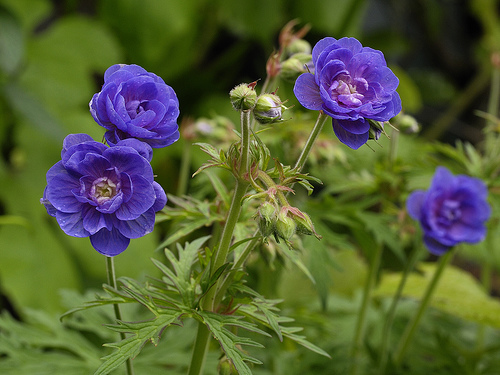
Meadow geranium ( Geranium pratense) - short root perennial, often found in the wild and having a lot of garden cultural forms, forms dense bushes up to 120 cm in height, flowers of blue-lilac color, bloom in June.
"Galaxy" - albino variety with white flowers with leaves of light green color.
"Mrs. Kendal Clark" -has light purple flowers with white venation, the bush tends to fall apart.
Rose Queen - has delicate light pink flowers with orange stamens; they look charmingly against the background of lush green foliage.
"Striatum" - a variety with original white flowers dotted with blue strokes and specks.
Splish Splash - similar to the previous variety with lilac strokes on the white field. The bush is more compact than other representatives of meadow geranium and its size does not exceed 60 cm. It blooms in June - early July.
This species also has terry forms: "Album Plenum" (white) Plenum Cerulium (purple-blue), Violatseum Plenum (blue-purple with a reddish center) and others.
In addition, there are varieties of meadow geraniums with black-purple and red-purple leaves, which are very effective in various combinations - "Victor Reuters", Midnight Reuters, "Purple Heron".
Geranium red-brown ( Geranium phaeum) - forest geranium species, naturally occurring in Central Europe. Perennial perennial perennial reaches half a meter (without peduncles), decorative thanks to the hemispherical shape of the bush and beautiful leaves, which grow back early after winter and persist until frost.
"Album" - A variety with fairly large white flowers and leaves of a light green color.
"Stilingflit GOST" - has an unusual pink-gray color of flowers and small dark green leaves.
"Lily Lowell" - one of the most spectacular forms, having large blue-purple flowers and light green openwork leaves.
There are also many variegated varieties with pale green or cream decoration - "Variegatum", Maggis Delight, "Tafs Jessher".
Geranium blood red ( Geranium sanguineum) - in nature, this species is found in the mountain forests of Europe and the Caucasus. Short-perennial perennial with strongly dissected rounded leaves, forms dense clumps up to 60 cm in height, blooms in June-July with pink flowers.
Of the most popular forms worth noting "Album"(white) "Prostranum" (pale pink with dark venation, the species is also known as "Striatum"), "Max Frey" (dark crimson). Dwarf cultivars 30-40 cm high - "Nanum", Jubili Pin, "Sheferds Warning".
Geranium krupnokorischnaya ( Geranium macrorrhizum) - found in wild form in the Carpathians and the Alps, large-perennial perennial, forming actively growing dense clumps, reaching 1 m in diameter, and not more than 40 cm in height. In a warm climate, the leaves come out green from under the snow. Popular cultural forms - "Whitness"(pure white) "Bivans Variety" (crimson-red), "Tsakor" (magenta), "Balkanum" (pale pink), variegated species are also available.
Geranium Ariantum ( Geranium errianthum) - in nature, this species is distributed from Eastern Siberia to Alaska, respectively, is very winter-hardy. Forms dense compact bushes up to 50 cm tall, flowers are collected in umbrella inflorescences of lilac-purple color.
Geranium Renard ( Geranium renardii) -caucasian geranium species, which is characterized by beautiful olive-green blistering leaves with wavy edges and equally beautiful white flowers with lilac venation. The height of the bush is not more than 20cm.
Dalmatian geranium ( Geranium dalmaticum) - one of the lowest species of geraniums, forms dense “cushions” with a height of not more than 10-15 cm. It blooms in mid-summer with bright pink flowers with a diameter of 3.5 cm.
Species that form a compact bush and have large leaves on long petioles, should be planted at a distance equal to twice the length of the petiole. Then the spherical shape of the bush will not be disturbed, giving the plant a special beauty.
Garden geraniums do not need special care, they do not need pruning - you can remove faded blossoms, but not necessarily, as they lower them themselves, hiding under the leaves. Branches of geraniums are so tightly closed that weeds practically do not grow under them and, therefore, they do not need weeding. And if the free areas to be mulched or planted with low-growing crops, then the need for loosening will disappear. Geranium is a very useful property - it never hurts with anything, moreover, garden geranium, highlighting around it a specific spicy aroma, saturated with essential oils and phytoncides, protects its neighbors in the flowerbed from diseases and pests.
Reproduction garden geraniums
Garden geraniums are propagated with rhizome segments and seeds. At one place without a transplant, a geranium bush can grow for 8-10 years or even more, and only then can the plant need rejuvenation of the bush. Dig a bush in the spring before flowering or after it. Only young, healthy rhizomes with developed buds are left, and old ones are removed. The plant very quickly forms new roots and takes root well in a new place.
The seed method is not as good as the previous one and is more laborious, moreover, it does not preserve varietal characteristics. It is better to sow fresh seeds, but to collect them is quite problematic, since when the leaves are fully ripe, the leaves burst and the seeds fly apart. Seedlings bloom the next year after planting.
Garden Geranium in Landscape Design
With its many advantages discussed above, garden geranium easily finds a place in any garden. Dwarf species are ideal for definition, they can also be used for mixborders and rabatok with roses, including standard roses. Geraniums can be used as a universal ground cover.
Geranium Renard is very good for landing in the foreground in gray or silver mixborders as a tonal or color contrast.
Forest geraniums will be especially beautiful in joint plantings on forest edges or among bushes with ferns, aquilegia, basil plants and other shade-tolerant plants.
Tall species of garden geraniums are used in mixed mixborders with other perennials to create “wild” landscape-style plots. In the foreground of such landings will be the most natural look unpretentious ground covers - a collar smb.,.
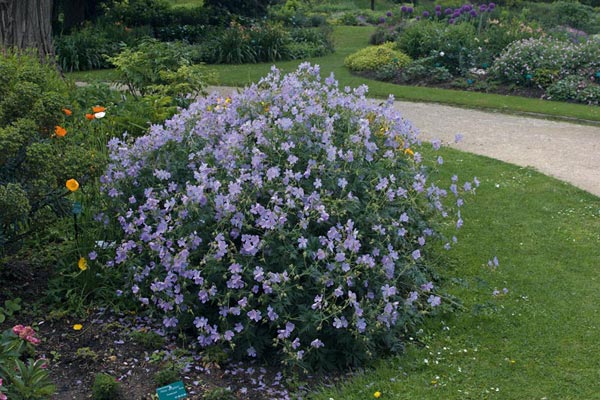
2010 - 2014,. All rights reserved.
Geranium (lat. Geranium) in everyday life has received the name of the crane. Gorgeous colorful plants are rightfully considered universal. Perennial and cold-resistant, not causing much trouble after planting, shade-tolerant and drought-resistant, they even multiply on their own. At the same time, not only flowers are a decoration of the garden, decorative and lush leaves.
Description
Often geraniums are called plants that are familiar to home window sills, namely, pelargonium, in the garden, they can only be in the warm season. Geranium winters quite calmly in the ground.
This is a separate genus of the geranium family. It is represented by hundreds of varieties of herbs and shrubs around the world. About 400 species of annual, biennial, perennial plants that are ubiquitous in temperate climates belong to the genus of geranium. The plant is well known to experienced gardeners and even beginners.
Geranium or crane
Spectacular appearance create noticeable leaves and bright inflorescences. The leaves are located on long petioles, dissected in various ways, in shape can be palchatolopastnymi, palchatorasdelnye, pinnate. Most species have pubescent soft-haired leaves, the glandular hairs of which are fragrant.
Large regular flowers consist of a 5-leaf calyx and a corolla with round petals, equally flat prostrate. Peduncles bear one to three flowers. Their color is the most diverse, dominated by white, purple and blue-violet tones, the scarlet color is not characteristic.

The structure of geranium (for example, red-brown geranium)
Species popular in floriculture
On the territory of Russia there are 40 species of geraniums. In gardening, the most popular are 12 South European species with numerous cultivated varieties.
There are high (from 50 cm) and low forms of geranium (up to 50 cm).
Geranium species most adapted to the climatic conditions of the middle zone are distinguished by various properties and characteristic features.
- Evergreen species: G. blood-red, G. red-brown.
- Species with the original color of leaves: G. krupnokorischestnaya, G. melkochynkovaya, G. Robert, G. Georgian.
- Light-loving species: Himalayan G., G. magnificent, G. Georgian, G. Renard, G. flat-cherished, G. close-knit, G. small-tongued.
- Shade-tolerant species: G. marsh, G. blood-red, G. meadow.
- Shade-loving species: G. Forest, G. Robert, G. Red-brown.
- Drought-tolerant species: G. Ashley, G. Renard, G. Dalmatian, G. Large-neuronal.
Photo gallery of species
Cultivation and care
Different species begin to bloom at different times, this diversity is desirable to take into account in terms of planting geraniums in the garden and flowerbed:
- At the end of May - G. Forest, G. Himalayan, G. large rooted;
- In the middle of June - G. Georgian, G. small-haired, G. Robert, G. blood-red;
- At the beginning of July - G. gorgeous, G. marsh, G. meadow, G. Renard;
- At the end of July - G. ashen.
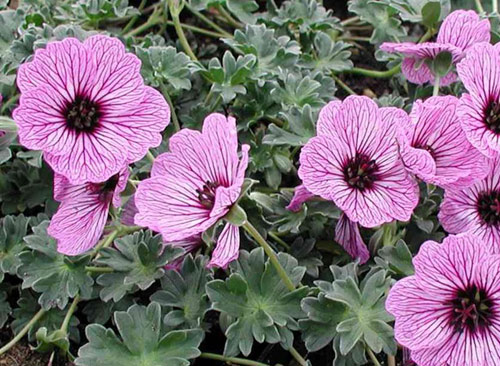
Ashen geranium
The flowering period for early species does not exceed 30 days, on average, lush inflorescences flaunt 30-40 days. Planted garden geraniums recommended islands - a few bushes nearby. Most of the cultivated varieties of geraniums can grow more than 10 years in one place, without requiring transplantation, division, although signs of aging, in the form of the withering of the middle of the bush, appear already for 6-8 years.
Winter-resistant perennials are more suitable for a garden, heat-loving ones are used as annuals or grown in indoor conditions.
Geranium is unpretentious, but, nevertheless, for successful growth and abundant flowering, it needs to create optimal conditions for development. It is quite simple to care for geraniums, you need to follow simple rules:
- Infrequent but abundant watering;
- Moderately nourishing soil;
- Regular feeding;
- High quality drainage;
- Timely removal of inflorescences.
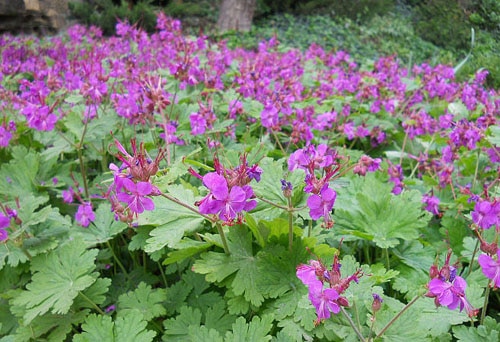
Geranium krupnokorischnaya
It is advisable to start by choosing a place where geranium will grow. Geranium is very sunny and well tolerated in direct sunlight, so it is preferable to choose a sunny, bright place, but partial shade is also suitable. More luxuriantly, geraniums bloom in periods of steadily warm spring, hot summers. At the same time, this plant is rather cold-resistant, experiencing frost in severe winters, in early spring delighting with the first leaves.
There are almost no requirements to the ground, with the exception of good water permeability, water stagnation is unacceptable. When planting geraniums in open ground, it is highly desirable to protect plants in advance from the possible proximity of groundwater. Watering is particularly important at the initial stage of growth and during long droughts. Geranium signals a lack of water with drooping leaves, which after watering are quickly restored. Loose, well-drained, fertile soils are highly desirable. Each type of geranium has its own preferences for soil acidity - most prefer neutral, slightly acidic and acidic. There are also Calcephils: Dalmatian, ashen, blood-red, Renard's geranium.
The abundance of watering is determined by the time of year: in summer, in spring, the plant needs abundant moisture, especially if the soil often dries out, and in winter and autumn, soil moisture should be moderate. The main thing during this period is to keep the root system from waterlogging. Watering with cold water can lead to diseases, against the backdrop of rotting roots. The plant is considered drought resistant, so it is better to slightly dry the geranium than to pour. Stagnant hydration is not terrible only marsh geraniums. On heavy, clay soils, geranium varieties successfully grow - meadow and sukova. Peaty soil is suitable for black-eyed geraniums.

The consequences of insufficient watering geraniums
Weeding is necessary in early spring, before the mass appearance of leaves. Periodically it is required to loosen the soil and fertilize it with a complex of mineral elements. Fading parts quickly die off, timely sanitary pruning is periodically necessary.
According to the growing conditions, the preferences of different types of geraniums are very different, so for a garden it is enough to choose several suitable species and provide them with proper care.
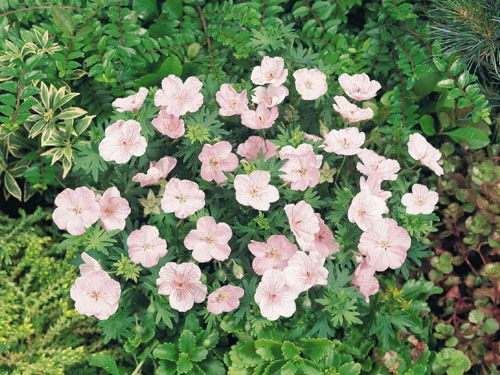
Geranium blood-red, grade "Vision Pink"
Wintering
Although most species are southern plants, they are quite cold-resistant. In varieties with wintering leaves (blood-red and red-brown geraniums), in the most severe frosts, leaves can grow that grow in spring, and flowering is still abundant.
Geranium feels pretty good in the winter in the open field without shelter. In the autumn, after withering and drying, one should carefully remove the above-ground shoots and leaves, placing them in the compost pit. Good results are obtained by mulching with a thick layer using organic matter - garden compost, wood chips, bark.
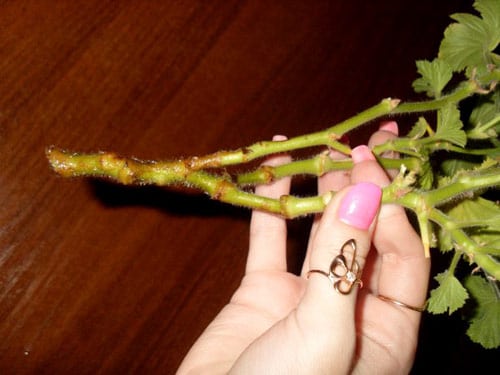
Pruning geraniums after flowering
Breeding
For geranium use seed and vegetative reproduction. Varietal geraniums are preferably propagated vegetatively.
Garden seeds are rarely propagated by seeds. This is due to certain features: the quality of seed, the complexity of the breeding process. It is difficult to collect the seeds independently due to the peculiarities of their full ripening - it is difficult to catch the moment of final ripening, they are suddenly scattered naturally.
When growing geraniums from seeds, sowing is carried out in the winter or in April. After harvesting in August, the seeds can be immediately sown in the soil freshly harvested, so that the seedlings have time to form before the onset of frost. It is even safer to sow the seeds in the winter in the ground, stuck frost, in which case they will germinate in the spring under the first favorable conditions. In May, friendly shoots appear, these seedlings bloom only next year.
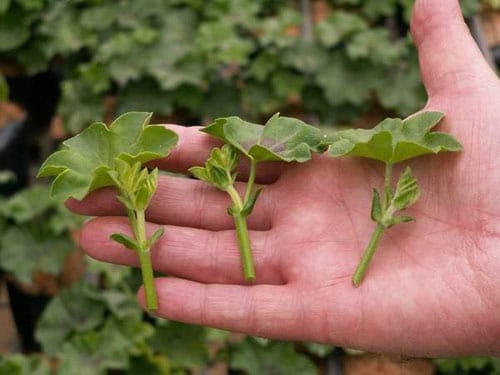
Geranium cuttings
Seeds bought in stores can be sown in the spring in greenhouse conditions in containers for seedlings, with a mandatory pick. Seedlings appear fairly quickly, they grow up, and already formed bushes are planted in a permanent place. Since in the future the plant can stay in a permanent place for a long time without dividing or transplanting, at least 50 cm is left between bushes, taking into account the growth rate.
Vegetative reproduction eliminates the interbreeding of varieties, as well as the extra work. Reproduction of geranium cuttings are used more often. Covering, the use of phytohormones is not necessary. For planting use small containers, filling them from the bottom with sand, above add nutrient mixture (sod land and humus). Watering moderate, without overflowing or drying the substrate.
Reproduction by layering allows you to get a viable new plant with an independent root system by autumn. With this method, the shoots of geraniums are placed in small grooves and simply sprinkled with earth.
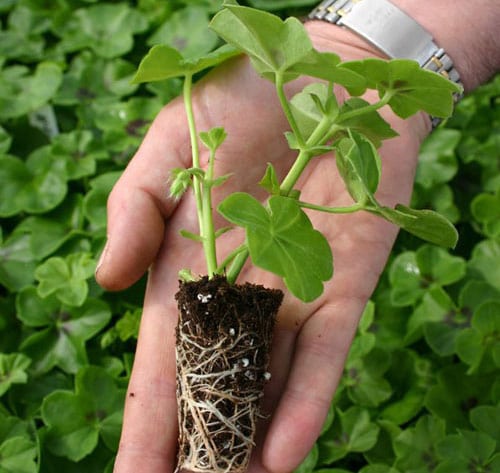
Garden geraniums are easily propagated by rooting cuttings
The number of plants can be increased by dividing the bush and rhizomes. An adult bush is dug out, divided into parts, which are immediately planted in a prepared place. If there is a need separated rhizomes can not be planted, and stored in cool conditions, using a container of sand, until the spring.
Diseases and pests
Geranium can be affected by pests - aphids, whitefly, various mites, etc. Biological insecticides are effective against them. One treatment can not be limited, because preparations do not affect all stages of insects. After 5-7 be sure to re-spraying.
Insufficient watering causes yellowing of the leaves. Bare at the bottom of the stems indicate a lack of light. Geranium is prone to diseases of the fungal nature: brown spot and powdery mildew. At an early stage, treatment with biofungicides is effective. With a strong lesion, the plant is better to remove and burn.
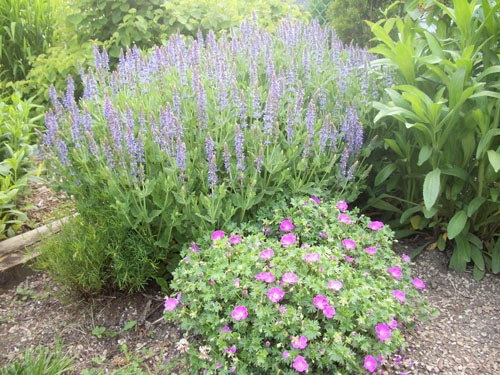
Geranium hybrid in partnership with sage oak wood
Use in landscape design
Garden geranium is surprisingly versatile and enjoys a well-deserved love of gardeners, perfectly combined with many ornamental herbs and flowers. Often used as a framing or background element.
Geraniums easily fill voids in flower beds, for example, among roses, decorate a decorative laying, with its help create bright various compositions on any site. It is good in natural areas of the garden, rockeries, on an alpine hill, among evergreen shrubs, large-leaved plants (Badan, rogers, hosts).
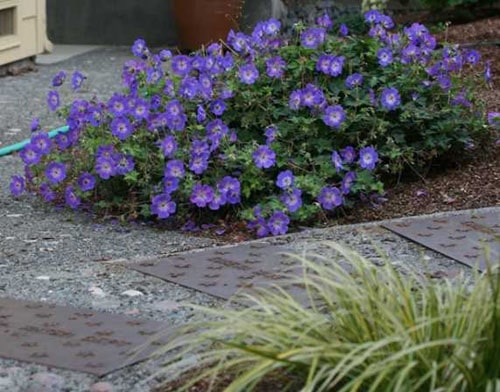
Garden geranium in landscape
The rare combination of excellent shade tolerance and drought tolerance of many species allows them to fill the most problematic areas of the garden with a dry shade. Geraniums, due to their strong, tenacious rhizomes, are excellent for decorating areas with a noticeable slant. Unpretentious geranium indispensable in the gardens of easy care.
Geranium leaves and roots have medicinal properties. Healing and its juice. Geranium is used for insomnia, neurasthenia, heart diseases and diseases of the gastrointestinal tract are treated. Its anti-inflammatory and antiseptic agents are widely used. It is known that geranium secretes bactericidal substances that have a detrimental effect on microbes.
Indoor geranium is familiar to most people since childhood. The second name of the flower - Pelargonium, its use in the landscape design of the garden has recently become widespread. This is due to the attractive appearance of the plant, the diversity of species and high healing properties. A more thorough acquaintance with an old acquaintance will reveal many interesting facts and, perhaps, in the near future, an aesthetic geranium will decorate your dacha.
Characteristics of the plant
Originally from Pelargonium from South Africa, its ability to bloom throughout the summer has provided widespread use not only as a houseplant, but also as a decoration for a balcony or a summer house.
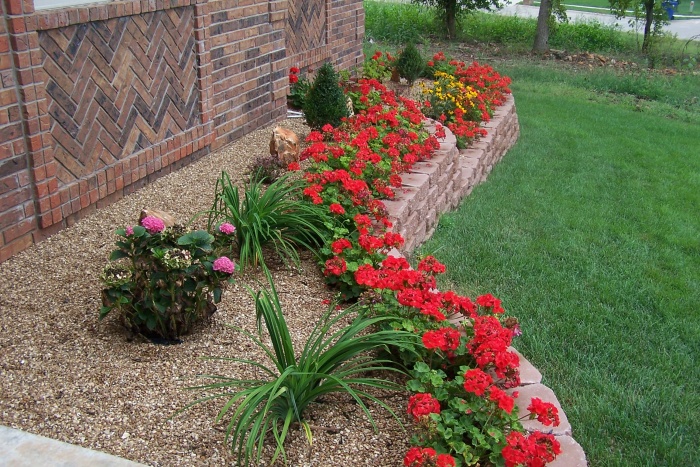
Landscaping experts prefer geraniums for landscaping for several reasons:
- easy care;
- variety of species allows you to elegantly complement any composition;
- possibility of disembarking in containers.
Different types of geraniums can be represented as herbaceous plants or subshrub, refer to perennial crops. In addition to a wide color palette, pelargonium inflorescences have a variety of shapes: they can be shields, umbrellas or large terry "caps". The stems of the geranium are straight, creeping or branching, while the leaves have a decorative appearance.
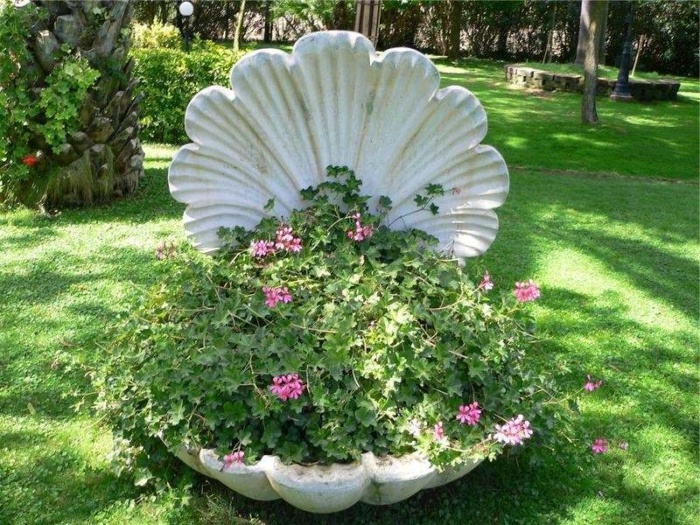
Choosing a favorable place
In order to get geraniums in the landscape design of the country for a long time, it is necessary to create favorable conditions for it. At the initial stage, a place should be selected that meets the requirements of the qualitative development of the plant. Preference is given to open sunny summer cottages, half-shaded areas are also acceptable.
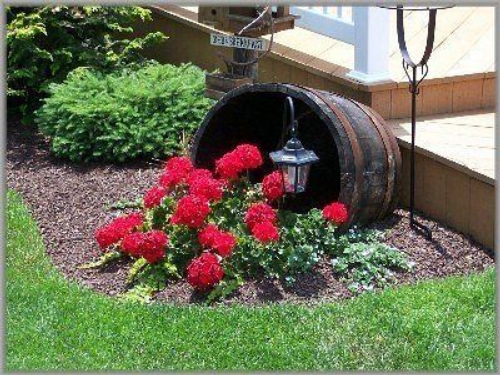
Pelargonium loves moist air and fertile soil with good drainage properties.
Tip! When choosing a place in the landscape design for classic geranium species, the location of the groundwater level is taken into account, the plant does not like too close proximity of moisture to the root system.
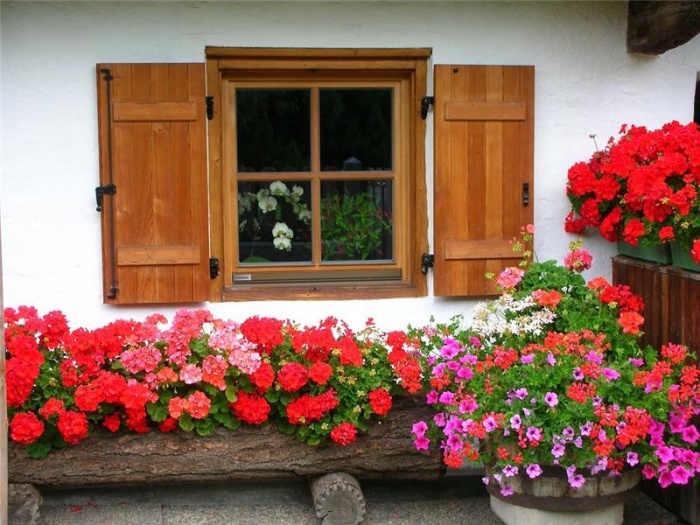
Rules for planting in open ground
Although pelargonium belongs to perennial flowers, the climate of the middle zone in winter is too harsh for it. Therefore, when grown in open ground, there are some features of landscape design geraniums:
- The optimal soil for a flower is neutral or slightly acidic.
- The structure of the soil is light, the presence of river sand or peat is welcomed.
- At autumn digging it is recommended to add mineral fertilizers and humus.
- Watering should be organized moderate, not allowing the land to dry out. A short-term drought geranium endure withstand.
- For the growth and development of pelargonium, the optimum air temperature is +15 o C. Therefore, a light shade in hot climates is welcome.
A variety of species implies the distinctive features of plants, but in most cases the conditions for planting and care are the same. For rooting at the dacha of green cuttings, they are planted in a mixed composition of river sand and peat; at home, perlite comes to the rescue.
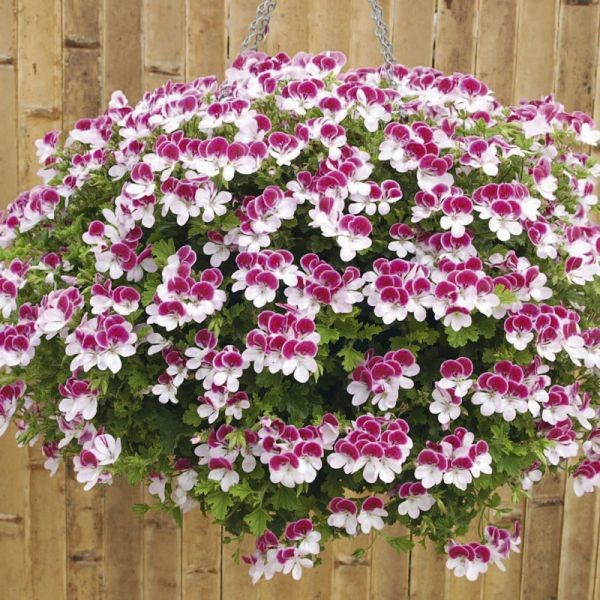
Pelargonium care
Being in the garden in the country, geranium is able to bloom all summer. But every living organism needs rest, therefore, about 2 months before the onset of winter cold, pelargonium translates into a state of rest. To do this is quite simple, it is enough to stop watering flowers and feeding them with mineral fertilizers. With the beginning of spring, geranium will wake up and illuminate the dacha with new flowering. It is better not to risk wintering the plants in the open field, it is much safer to transplant pelargonium into the pot and bring it home.
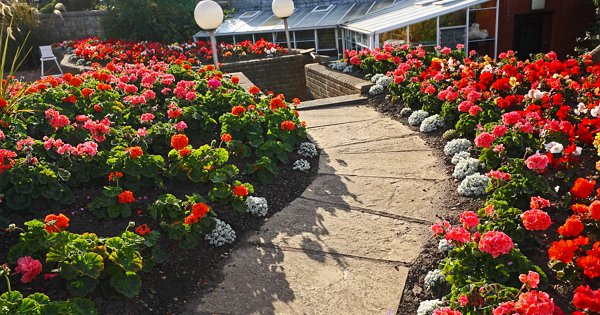
In order for the dacha's landscape design to adorn the lush flowering of the geranium for a long time, it needs a complex top dressing intended for flowering plants and regular loosening of the soil.
Pruning of pelargonium in the spring will be prompted by pruning; for this, the tips of the shoots are pinned. Throwing them away is not necessary, having rooted the waste in the country, you will get additional geranium flowers in the landscape design of the site.
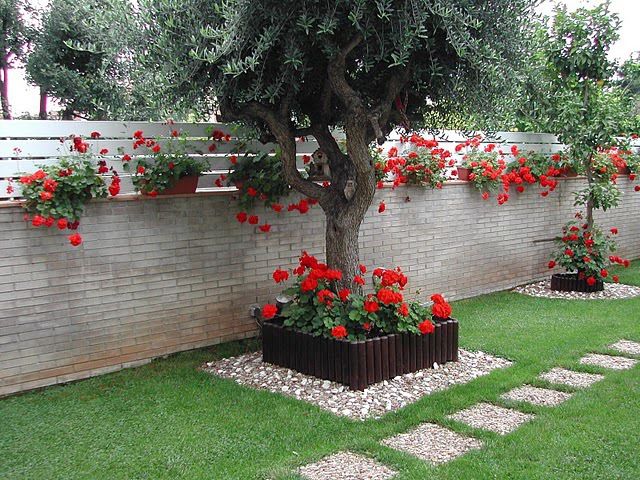
Watering pelargonium requires a dosed approach. This plant does not favor overly moist soil. The natural excess of moisture that has formed as a result of prolonged rains, geranium will transfer, and artificial irrigation in excess of the need, can lead to the death of the plant.
Tip! Faded geranium leaves, located in the lower part of the trunk, are prone to rapid extinction. Leaving them on pelargonium is not recommended, regular cutting of the dipped greens will retain the strength of the rest of the flower.
In the autumn, when geranium begins to dry and wither, the leaves and ground shoots are removed and carried outside the territory of the cottage.
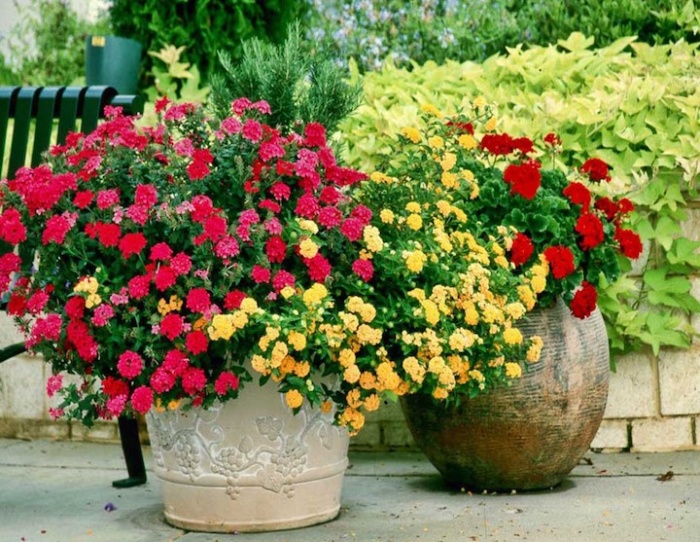
Breeding conditions
Decorating landscaping cottages geranium can be infinite, the multiplicity of species will not allow monotony. There are two main ways of reproduction of pelargonium - vegetatively (green cuttings) and by sowing seeds.
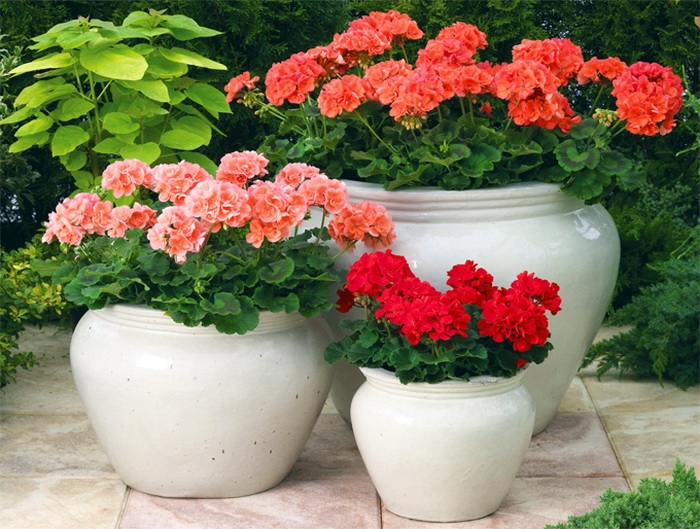
Which method is more convenient and effective, decide on your own, after reading the conditions of each:
- Winter is the most suitable period for the beginning of geranium breeding, since by the beginning of the spring period the new sprouts of a beloved flower can already complement the landscape design of the dacha. Vegetative method involves planting pelargonium cuttings in perlite or sand, followed by moistening. The cutting is cut from the mother plant of the geranium transported from the dacha and stored at home at a temperature not exceeding +12 o C. From January, under conditions of 16-degree heat, the cuttings of the geranium begin to root, after which the temperature can be increased by another 5 degrees. The root system of the pelargonium process is formed over a period of 20 days; after the process is over, geranium can be transplanted into compact pots and put in a greenhouse for the purpose of hardening. Further development before landing in the country can be continued on the window.
- The period for seed reproduction of geranium is similar to the cutting method, the winter months are optimal for starting the procedure of breeding pelargonium. Seeds are placed in a prepared mixture consisting of peat and river sand. Lack of the latter is not a significant problem. After 20 days, the first shoots of the future beauty of geranium should appear. During this period, the soil is moistened and covered with a film. After forming on the young Pelargonium three full leaves, the seedlings dive into separate containers. So that the geranium at the dacha has a bushy form, after 6 leaves the plant is pinched.
Remark! Geranium is prone to rapid growth, so when planting pelargonium in the country in the ground, take care of a sufficient amount of free space.
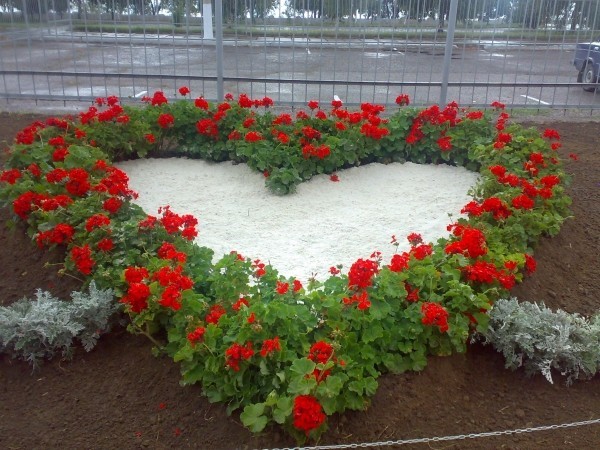
Diseases and pests
Geranium in the country is usually not prone to diseases, but landscape design experts warn of possible minor damage to the flower with powdery mildew or brown spot. Preventing the spread of the disease will help timely cutting the plant in the country immediately after flowering. This helps to strengthen the geranium, healthy young shoots will endure the autumn cooling. This also applies to large pelargonium bushes damaged in the country by the disease. At the end of the flowering period, they are completely mown. In their place will grow a new healthy plant.
When the geranium is damaged by brown spot, the shoots are immediately cut and destroyed by fire. Infection with fungal infection occurs exclusively in the rainy and cold summer, the geranium bush as a whole is not in serious danger.

Occasionally, damage to the root system of pelargonium by the larvae of the beetle beetle. In this case, geranium stops growing. The dried edges of the leaves appear as a result of their eating by the adult beetle. You can detect pests at night by digging up the plant and checking the root. When identifying the larvae, they should be eliminated, the root and the whole flower pelargonium sprayed with a solution of fungicide.
Types of Pelargonium
Making out the landscape design of the dacha with pelargonium is a fascinating occupation, because the plant has about 250 species.
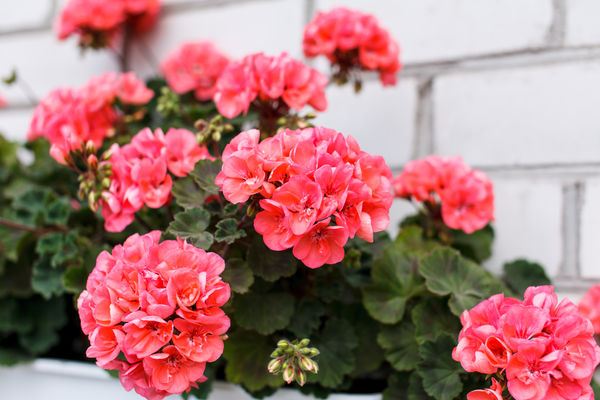
In our region, the most widespread are the following types:
Pelargonium zonal. The foliage of the flower has a light or dark green shade. This geranium is not intended for wintering in open ground, but needs to be transplanted and stored at a temperature not higher than 23 o C. Pelargonium zonal is resistant to drought, but does not tolerate excess moisture. Flowers can have white color and shades of red: crimson, pink, dark red. Such geranium develops beautifully in flowerbeds, in containers, flowerpots and curbs.
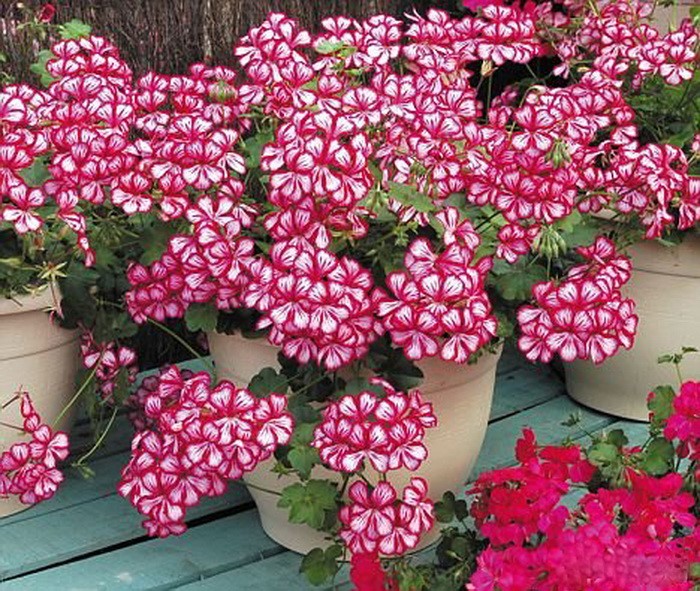
Ileum Pelargonium It is actively used by landscape design specialists for vertical gardening of a summer house. Fleshy leaves, sometimes with red trim, emphasize attention. The lack of smell and hairiness makes the leaves of this geranium look similar in shape to ivy leaves. Depending on the variety, the length of the falling shoots varies from 30 to 90 cm. When transplanting for the winter period from the summer cottage to home conditions, geranium can bloom for the next season. Flowers are lilac, white, red and pink. Basically, they have a terry fluffy look and bright color.
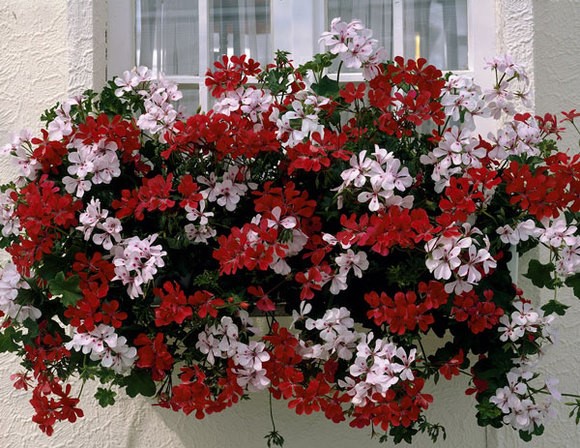
On what grade of pelargonium you do not stop, the refinement of landscape design of the country house during the entire flowering period will be undeniable.
Bright floriferous flower Pelargonium is grown in a garden in a flower bed, in flowerpots and at home on a windowsill or balcony. In the room floriculture is one of the favorites, the popular name of which is Geranium. Thanks to the selection of the commoner flower, as it used to be, it was transformed not only in the color scheme, but also in a well-known form. There were terry varieties, miniature, stellate, ivy, dwarf, cactus and many other species.
Pelargonium is grown from seeds, but there are some species that propagate only in a vegetative way, they are expensive and are not a frequent guest in the garden or on the windowsill. Typically, when seed propagation of flowers, varietal characteristics are lost, but thanks to selection work, varieties of pelargonium resistant to this type of reproduction have appeared (semi-double, terry, rosaceous, cascade pelargonium, and others). Hybrids (F1) and (F2) grow compact and unpretentious, painlessly tolerate any changes in the care. For a novice grower the most it!
Pelargonium planting
Pelargonium seeds are large, have a high level of germination. Before buying, pay attention to the date and group. Multiflora - undersized, compact, blooming and resistant to the wind, draft and rain, and grandiflora - compared with the previous tall flower, moderately flowering, but with more pronounced flowers and inflorescences.
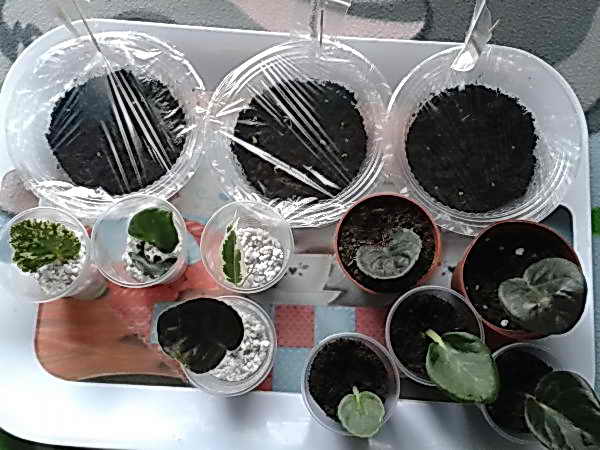 Sowing seed pelargonium seedlings spend from late December to February (in February the light day increases and this is important for the flower). Before sowing, soak the seeds in a strong saline solution, empty substandard seeds will float up, throw them away, and rinse the rest under running water and soak for 12 hours, plant in medium size. Next, place these tablets in a flowerpot and fill the remaining space with a mixture of soil and a handful of wood ash. Landing cover with foil or clear glass, put in a warm place.
Sowing seed pelargonium seedlings spend from late December to February (in February the light day increases and this is important for the flower). Before sowing, soak the seeds in a strong saline solution, empty substandard seeds will float up, throw them away, and rinse the rest under running water and soak for 12 hours, plant in medium size. Next, place these tablets in a flowerpot and fill the remaining space with a mixture of soil and a handful of wood ash. Landing cover with foil or clear glass, put in a warm place.
After 7-14 days, the first shoots appear, usually at the same time. Remove the shelter and put on the light, with a lack of natural lighting to use the lamp. Water the seedlings gently, at the root, for convenience, you can use a syringe.
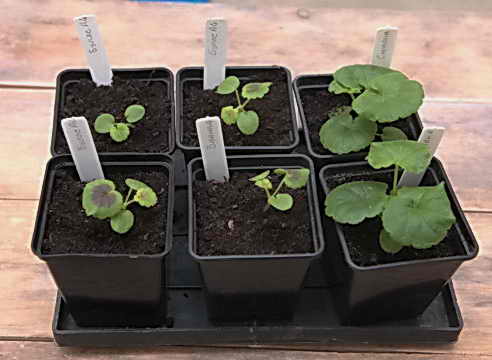
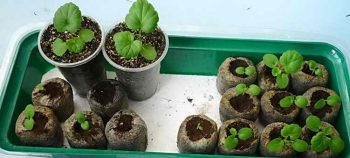
Transplantation of pelargonium in open ground or pot
Due to sowing in peat tablets, pickling is not required, and transplanting pelargonium into open ground or a pot will take place painlessly for plants and as quickly and conveniently as possible for the florist. In May, when the weather becomes stable, warm seedlings can be transplanted to a flower bed or into large flowerpots of 3-4 seedlings, depending on the size of the flowerpot. Plant not a lot, otherwise because of the small space flowering will be weak. Pelargonium planted in loose soil, which includes sand, peat, vermiculite and leaf earth.
From sowing seeds to flowering takes 5-6 months.
Care
Water moderately, stagnant water contributes to the spread of fungal diseases and the decay of the root system. And with a lack of watering flowering stops, the leaves turn yellow.
When feeding pelargonium, use nitrogen fertilizer as little as possible so that the flower does not fatten and does not develop only green mass to the detriment of flowering.
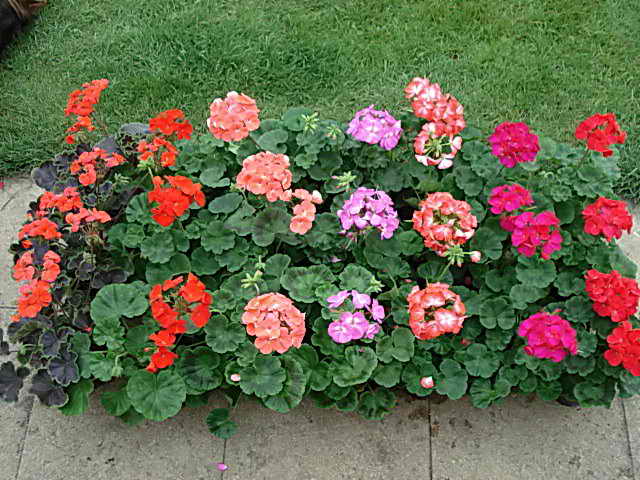 Pelargonium seeds are harvested after darkening of the seed pods. They can be sown immediately and grown as a houseplant, or wait until the end of winter.
Pelargonium seeds are harvested after darkening of the seed pods. They can be sown immediately and grown as a houseplant, or wait until the end of winter.
In the fall, before wintering, the plant is cut to a stump, leaving shoots 10-15 cm high. At this time, flowering can still continue, but you should not regret it, because you need to protect from frost. Bushes to dig and plant in pots filled with soil and washed river sand. Put on the windowsill until spring. At night, the temperature should not be lower than + 6 ° С, and during the day it should be within 12-15 ° С; for variegated varieties, the temperature should be kept higher. To water only through the pallet.
In late February, again pruning grown sprouts, and in March-April to feed complex mineral fertilizer. If you take the pots to a balcony or gazebo during the day, the plants will survive the temperature to -3 ° C, cover them with agrospan or bring them into the house at night.
Cutting pelargonium cuttings are not thrown away, but rooted, after having been dipped in c. Cover for 2-3 weeks until rooted. Such pelargoniums from cuttings are grown as annuals. In comparison with pelargoniums grown from seeds, they are less decorative, but they are quite useful for filling the voids in the flowerbed, especially when it is not possible to get seeds.
